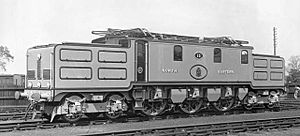British Rail Class EE1 facts for kids
Quick facts for kids British Rail Class EE1 |
|
 |
|
| Power type | Electric |
|---|---|
| Builder | North Eastern Railway Darlington Works |
| Build date | 1922 |
| Total production | 1 |
| Configuration | 2-Co-2 |
| UIC classification | 2'Co2' |
| Gauge | 4 ft 8 1⁄2 in (1,435 mm) |
| Driver diameter | 6 ft 8 in (2.03 m) |
| Locomotive weight | 110.05 long tons (111.82 t) |
| Electric system(s) | 1500 V DC |
| Current collection method | Pantograph, 2 off |
| Traction motors | 300 hp (224 kW) Metropolitan Vickers, 6 off |
| Power output | 1,800 hp (1,300 kW) |
| Tractive effort | 28,000 lbf (124.6 kN) |
| Train heating | Steam generator |
| Train brakes | Vacuum |
| Career | North Eastern Railway London and North Eastern Railway British Railways |
| Number | NER: 13 LNER: 13; later 6999; BR: 26600 |
| Axle load class | Route availability 7 |
| Disposition | Stored 1923–1950; scrapped 1950 |
The British Rail Class EE1 was a very special electric locomotive built in 1922. It was designed to pull fast passenger trains. Only one of these powerful electric trains was ever made.
This unique locomotive was first ordered by the North Eastern Railway. Later, its ownership changed hands. In 1923, it became part of the London and North Eastern Railway (LNER) and then, in 1948, it joined the fleet of British Railways.
Contents
What Was the EE1 Locomotive?
The EE1 was an electric locomotive, which means it ran on electricity instead of coal and steam. It was built to be very powerful, with 1,800 horsepower. This was a lot of power for a train back in the 1920s!
Why Was It Built?
The North Eastern Railway wanted to use electric trains for their express passenger services. They planned to electrify (add electric power lines to) a main railway line. The EE1 was meant to be the first of these new, fast electric trains.
How Did It Get Power?
The EE1 collected electricity from overhead wires. It used two special arms called pantographs to touch the wires and bring power into the train. This power was 1500 V DC.
Who Built This Unique Train?
The EE1 locomotive was built by the North Eastern Railway itself. They constructed it at their Darlington Works in 1922. This workshop was famous for building many different types of railway engines.
A One-of-a-Kind Design
The EE1 was the only train of its kind ever built. It had a special design with a wheel arrangement known as 2-Co-2. This means it had two small wheels at the front, six large driving wheels in the middle (arranged in two sets of three), and two small wheels at the back.
The EE1's Short Journey
Even though the EE1 was a very advanced train, it didn't get to run much. The plans to electrify the main railway line were changed. Because of this, there wasn't a suitable track for the EE1 to run on.
Stored Away
After it was built, the EE1 was mostly kept in storage. It stayed in storage for many years, from 1923 until 1950. It was a powerful train that never really got to show what it could do.
The End of the Line
In 1950, the EE1 locomotive was finally scrapped. This means it was taken apart and its materials were reused. It was a sad end for such an innovative and unique electric train.

